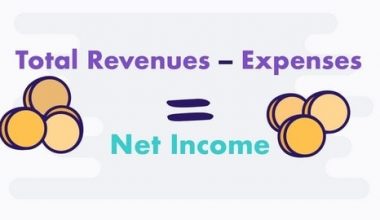Lenders make money by charging interest when you take out a loan. To put it another way, interest is the cost of borrowing money from a lender. That is, when you repay the loan, you will pay the initial loan amount plus interest. Lenders charge interest in a variety of ways. Some use a “basic interest method,” while others may charge interest based on an amortization schedule, which applies higher interest during the loan’s early stages. Your credit history, loan size, and loan conditions are all factors that influence the amount of interest you pay. Here’s how to calculate loan interest on a loan per month.
What is Loan Interest?
When you take out a loan, you must repay both the principal and the interest, which is how lenders make a profit. Consider interest to be the amount of money charged by the lender for access to the loan funds.
Every year, the interest rate is expressed as a percentage of the total loan amount. With an amortized loan, your monthly payments go toward both the interest and the principal. The ratios will change over the life of the loan.
Simple interest
The simplest way to calculate interest is by using simple interest. The simple interest formula is used to calculate how much interest you will pay on a loan that does not compound. Calculating simple interest can show you how much money you can save by making extra monthly payments on your loan.
Amortizing loans
Many loans, including mortgages, auto loans, and student loans, are amortized, which means that each of your monthly payments includes a percentage of the loan’s total outstanding principal and interest.
The first few months of loan repayment are dominated by interest payments. The amount of your monthly payment that goes toward interest reduces over time, while the amount that goes toward principal increases.
To better understand how your interest rate affects your monthly payment and the total amount of interest you’ll pay over the life of the loan, use a loan calculator.
Annual Percentage Rate vs. Loan Interest
Usually, the rate quoted by a lender is the annual percentage rate (APR), which is a combination of interest, fees (such as an origination fee), and other costs. Your annual percentage rate (APR) is the annual percentage of your loan principal (the total amount borrowed) that you pay each year to borrow that money.
Your APR may be the only number you care about functionally, so be aware that there is a difference between it and your actual interest rate. You may use the same formula to calculate how much you’ll pay if you use the APR instead of the interest rate.
How to Calculate Interest on a Loan
It can be difficult to calculate the interest rate on a personal loan. However, most lenders use simple interest rather than compound interest, making the job a little easier.
To calculate your simple interest, multiply the principal (P) by the interest rate (R) by the time period in years (T), then divide the result by 100. Many online lenders offer calculators that will do the math for you.
Lenders calculate interest using a variety of methods, some of which are far more sophisticated than others. Most lenders, however, employ the basic interest method.
Simple Interest Calculator
To calculate simple interest on a loan, multiply the principal (P) by the interest rate (R), then divide the total by 100. To use this formula, make sure you express your interest rate as a percentage, not a decimal (for example, 4% would be entered as 4, not 0.04).
Simple interest = principal (P) x interest rate (R) x loan term in years (T) / 100.
Amortization Calculator
The simple interest formula is not used in all loans. Mortgages are amortized loans, which means that the monthly payment is fixed. Your amortization plan specifies how much of each payment is allocated to interest and how much goes to the principal. The following is the simplest way to calculate your amortization loan:
Principal payment = monthly payment – interest due for the period
Because your principal fluctuates monthly with an amortization loan, your unique calculation changes all the time.
- Divide your interest rate by 12 to calculate your monthly interest owed. for example, A loan with an interest rate of 8%, would be.007 (.08 divided by 12).
- If you have a $400,000 mortgage with an 8% interest rate, your first interest charge would be $2,666.67. If your monthly payment is $2,935, $268.33 will be applied to the principal.
- Using your new loan principal of $399,6731.67, you would calculate interest the following month.
How to Calculate Interest Per Month
Calculating interest on a monthly basis is a necessary skill. Interest rates are often given as an annualized percentage, such as an annual percentage yield (APY) or an annual percentage rate (APR). It’s helpful to know how much that is in dollars and cents. We frequently think in terms of monthly expenses.
You might have monthly electricity bills, food expenses, or a car payment, for example. Interest is also a monthly (if not daily) event, and regular interest calculations add up to large sums over the course of a year. The process of converting from an annual rate (APY or APR) to a monthly interest rate is the same whether you’re paying interest on a loan or receiving interest in a savings account.
Monthly Interest Rate Calculation Example
Divide the yearly rate by 12 to reflect the 12 months in the year to calculate an interest rate each month. To complete these steps, you must convert from percentage to decimal format.
Example: Assume you have an APY or APR of 10%. What is your interest rate every month, and how much would you spend or earn on $2,000?
- Convert the annual rate from a percent to a decimal by 100: 10/100 = 0.10
- Take that figure and divide it by 12 to get the monthly interest rate in decimal form: 0.10/12 = 0.0083
- To calculate the interest each month on $2,000, multiply that figure by the total amount: 0.0083 x $2,000 = $16.60 per month
- Convert the decimal monthly rate to a percentage (by multiplying by 100): 0.0083 x 100 = 0.83%
The monthly interest rate on your loan is 0.83%.
The above example illustrates how to calculate an interest rate and costs for a single month using the simplest possible method.
For months, days, years, or any other period, you can calculate interest. The rate you use in calculations is known as the “periodic interest rate,” regardless of the term you choose. Most rates are given as an annual rate, so you’ll need to change it to a rate that fits your question or financial product.
Factors That Influence the Amount of Interest Paid
Many factors can influence how much interest you pay on a loan. Here are some of the most important factors that can influence how much you pay over the life of the loan.
#1. Loan amount
The amount of money you borrow (your principal loan amount) has a significant impact on the amount of interest you pay to a lender. The larger the amount borrowed, the higher the interest rate because the lender assumes the greater risk.
On an amortized schedule, if you borrow $20,000 for five years at 5% interest, you will pay $2,645.48 in interest. If you leave all other loan factors constant (for example, rate, term, and type of interest), but increase your loan amount to $30,000, the interest you pay over five years will be $3,968.22.
#2. Interest rate
When calculating the cost of borrowing, your interest rate is important. Poor credit often means paying a higher interest rate.
Keeping with the previous example ($20,000, five-year term, amortized interest), let’s compare a 5% loan against a 7% loan. The total interest cost on the 5% loan is $2,645.48. The interest cost increases to $3,761.44 if the interest rate goes to 7%.
You’ll also need to decide whether the interest rate on your five features is fixed or variable. If it is variable, your interest costs may change over the life of your loan, which will affect how much it will cost you in total.
#3. Loan term
A loan term is the amount of time that a lender agrees to extend your payments. If you are approved for a five-year auto loan, your loan duration will be 60 months. Mortgages, on the other hand, often have loan durations of 15 or 30 years.
The number of months it takes to repay the money you borrowed might have a big impact on your interest costs.
Shorter loan terms usually mean higher monthly payments, but you’ll pay less interest because you’ll have less time to pay back the loan. Longer loan terms may reduce the amount you need to pay each month, but because repayment is spread out, the interest paid will be higher over time.
#4. Repayment schedule
Another thing to consider when calculating loan interest is how frequently you make payments to your lender. The majority of loans require monthly payments (though some require weekly or biweekly payments, especially in business lending). There’s a chance you’ll save money if you make payments more frequently than once a month.
If you make payments on your loan more often, you can pay off the principal of your loan faster. Extra payments can save you a lot of money in many cases, such as when a lender charges compound interest. However, ensure that the payments are used to decrease the principal.
#5. Repayment amount
The repayment amount is the monthly payment you must make on your loan. Paying more than the monthly minimum can result in savings in the same way that making more frequent loan payments might save you money on interest.
How to Get the Most Competitive Interest Rates
There are a few things you can do to enhance your chances of getting the best interest rate on a loan:
- Improve your credit score: Those with the greatest credit scores usually have access to the most competitive interest rates.
- Choose a shorter repayment period: The best interest rates are always associated with the shortest-term loans. If you can afford the payments, you will pay less interest over time.
- Lower your debt-to-income ratio (DTI): Your DTI ratio is the amount of debt you pay each month as a percentage of your gross monthly income. When it comes to qualifying for a competitive loan, it is almost as important as your credit score.
How Do I Calculate Interest Per Month?
Divide your annual rate of interest by the number of payments you’ll make. If your interest rate is 6% and you make monthly payments, divide 0.06 by 12 to get 0.005. Multiply that amount by your remaining loan balance to get how much interest you’ll pay that month.
What is the Easiest Way to Calculate Interest?
To calculate simple interest, just multiply the principal amount by the interest rate and the time. The formula written out is “Simple Interest = Principal x Interest Rate x Time.” This equation is the simplest way to calculate interest.
How Do You Calculate the Annual Interest Rate?
The following is the formula and calculation:
- Effective annual interest rate = (1 + (nominal rate ÷ number of compounding periods)) ^ (number of compounding periods) – 1.
- For investment A, this would be: 10.47% = (1 + (10% ÷ 12)) ^ 12 – 1.
- And for investment B, it would be: 10.36% = (1 + (10.1% ÷ 2)) ^ 2 – 1.
What are Interest and Formula?
Simple interest is calculated as S.I. = P × R × T, where P = Principal, R = Rate of Interest in % per annum, and T = Time, commonly expressed as the number of years. The interest rate is expressed as a percentage, r%, and is written as r/100.
How to Calculate the Interest Rate on a Loan?
To calculate simple interest on a loan, multiply the principle (P) by the interest rate (R) and the loan period (T), then divide by 100. Make sure to write your interest rate as a percentage and not as a decimal when using this formula.
How Do You Figure Out Interest On a Loan?
Principal loan amount x interest rate x loan term = interest
Conclusion
Before taking out a loan, you must calculate how much interest you will pay to understand the true borrowing costs. Ask the lender if they use the simple interest formula or an amortization schedule to figure out interest, and then use the right formula or an online calculator to figure out the numbers.
Also, keep in mind the factors that will influence the amount of interest you pay. To keep more of your hard-earned money in your pocket, it may be smart to borrow less or decrease the payback time. Furthermore, you should improve your credit score before applying and shop around for the best loan rate.
Related Articles
- Mortgage Calculator Amortization: A Comprehensive Guide (Updated)
- Amortization Schedule, Loans, and Calculations
- ACCUMULATED AMORTIZATION: Definition And All You Should Know
- PRINCIPAL PLACE OF BUSINESS LLC: Definition & Examples
- HOW TO PAY OFF MORTGAGE IN 5 YEARS: A Comprehensive Guide






